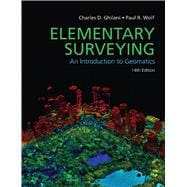Elementary Surveying, Fourteenth Edition, is ideal for Surveying courses offered in Civil Engineering departments and is a useful reference for civil engineers.
This highly readable, best-selling text presents basic concepts and practical material in each of the areas fundamental to modern surveying (geomatics) practice. Its depth and breadth are ideal for self-study. Elementary Surveying, Fourteenth Edition, is updated throughout to reflect the latest advances and technology.
Teaching and Learning Experience
This program will provide a better teaching and learning experience—for you and your students. It will help:
- Emphasize the Theory of Errors in Surveying Work: Common errors and mistakes are listed to remind students to exercise caution in their work.
- Use Strong Pedagogy Tools to Teach: Numerous worked example problems, figures, illustrations, and end-of-chapter problems help students apply concepts.
- Reflect the Latest Advances in Technology: To keep your course current and relevant, this edition covers the latest advancements in surveying technology.








